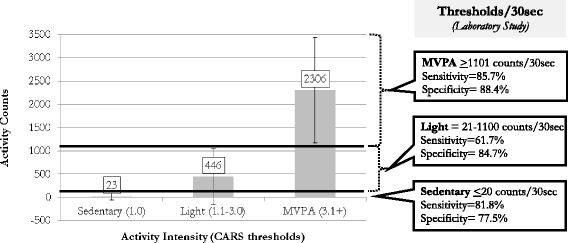Toddler physical activity study: laboratory and community studies to evaluate accelerometer validity and correlates
- PMID: 27600404
- PMCID: PMC5011903
- DOI: 10.1186/s12889-016-3569-9
Toddler physical activity study: laboratory and community studies to evaluate accelerometer validity and correlates
Abstract
Background: Toddlerhood is an important age for physical activity (PA) promotion to prevent obesity and support a physically active lifestyle throughout childhood. Accurate assessment of PA is needed to determine trends/correlates of PA, time spent in sedentary, light, or moderate-vigorous PA (MVPA), and the effectiveness of PA promotion programs. Due to the limited availability of objective measures that have been validated and evaluated for feasibility in community studies, it is unclear which subgroups of toddlers are at the highest risk for inactivity. Using Actical ankle accelerometry, the objectives of this study are to develop valid thresholds, examine feasibility, and examine demographic/ anthropometric PA correlates of MVPA among toddlers from low-income families.
Methods: Two studies were conducted with toddlers (12-36 months). Laboratory Study (n = 24)- Two Actical accelerometers were placed on the ankle. PA was observed using the Child Activity Rating Scale (CARS, prescribed activities). Analyses included device equivalence reliability (correlation: activity counts of two Acticals), criterion-related validity (correlation: activity counts and CARS ratings), and sensitivity/specificity for thresholds. Community Study (n = 277, low-income mother-toddler dyads recruited)- An Actical was worn on the ankle for > 7 days (goal >5, 24-h days). Height/weight was measured. Mothers reported demographics. Analyses included frequencies (feasibility) and stepwise multiple linear regression (sMLR).
Results: Laboratory Study- Acticals demonstrated reliability (r = 0.980) and validity (r = 0.75). Thresholds demonstrated sensitivity (86 %) and specificity (88 %). Community Study- 86 % wore accelerometer, 69 % had valid data (mean = 5.2 days). Primary reasons for missing/invalid data: refusal (14 %) and wear-time ≤2 days (11 %). The MVPA threshold (>2200 cpm) yielded 54 min/day. In sMLR, MVPA was associated with age (older > younger, β = 32.8, p < 0.001), gender (boys > girls, β = -11.21, p = 0.032), maternal MVPA (β = 0.44, p = 0.002) and recruitment location (suburban > urban, β = 19.6, p < 0.001), or race (non-Black > Black, β = 18.5, p = 0.001). No association with toddler weight status.
Conclusions: Ankle accelerometry is a valid, reliable, and feasible method of assessing PA in community studies of toddlers from low-income families. Sub-populations of toddlers may be at increased risk for inactivity, including toddlers that are younger, female, Black, those with less active mothers, and those living in an urban location.
Keywords: Accelerometry; Activity correlates; Low-income; Obesity prevention; Physical activity assessment; Toddler; Very young children.
Figures

References
Publication types
MeSH terms
Grants and funding
LinkOut - more resources
Full Text Sources
Other Literature Sources
Medical

